#Battle of Quatre Bras
Explore tagged Tumblr posts
Text
Time Travel Question : 19th Century IV and Earlier
These Questions are the result of suggestions from the previous iteration.
This category may include suggestions made too late to fall into the correct grouping.
Please add new suggestions below if you have them for future consideration.
#Time Travel#19th Century Paris#coca wine#absinthe#expressionists#19th Century#Pre-Raphaelites#Art History#Vienna#Statue of Liberty#Victor Hugo#Georg Wilhelm Steller#Steller's Sea Cows#18th Century#Extinct Animals#Sea Creatures#Duchess of Richmond#Brussels#Napoleonic Wars#Battle of Quatre Bras#South America#Charles Darwin#History of Science
171 notes
·
View notes
Text

Portrait of Napoleon on horseback, at the Battle of Ligny '16me Juin 1815'
French School, early 19th century
#napoleon bonaparte#napoléon bonaparte#napoleonic wars#napoleonic#quatre bras#ligny#waterloo#belgium#netherlands#france#art#battle of ligny#battle of waterloo#battle of quatre bras#history#europe#european#emperor#horseback#horse#marengo#portrait#the hundred days#hundred days#war#battle#napoleon#napoléon#bonaparte
54 notes
·
View notes
Text

The Black Brunswicker
Artist: John Everett Millais (British, 1829–1896)
Date: 1860
Genre: Genre Art
Medium: OIl on canvas
Collection: Lady Lever Art Gallery, Merseyside, England, United Kingdom
Description
The theme of ‘The Black Brunswickers’ is an imaginative incident depicting a historical moment. The Black Brunswickers were a special troop raised by Frederick William, Duke of Brunswick (1771 - 1815) in 1809. The regiment consisted of the best German gentlemen and was known as the ‘Death or Glory’, a name which derived from their distinctive death’s head hat badge and their apparent devotion to duty. The troops suffered severe losses at the battle of Quatre Bras at Waterloo in 1815. In a letter to his wife Effie, Millais described his idea and his enthusiasm for the subject:
"My subject appears to me, too, most fortunate, and Russell (the war correspondent of The Times) thinks it first-rate… I have it all in my mind’s eye and feel confident that it will be a prodigious success. The costume and incident are so powerful that I am astonished it has never been touched upon before. Russell was quite struck with it, and he is the best man for knowing the public taste. Nothing could be kinder than his interest, and he is to set about getting all the information that is required."
Millais spent three months painting ‘The Black Brunswickers’. Studies for the work exist both in the Lady Lever Art Gallery’s archives as well as in Tate Britain. Millais used Charles Dickens’s daughter, Kate, as the model for the girl and a private in the Life Guards for the soldier. Each had to model separately using a lay figure to lean against.
Millais wished to be historically accurate in making the girl’s dress look quite antique (it is actually a compromise between the fashions of 1809 and 1815 when waists were still kept high). The intensity of emotions is well conveyed in the close encounter of the couple, the girl’s body attempting to obstruct the soldier from his task and prevent his destiny.
The dark and enclosed space enhances the tragedy of the scene, and the work appeals both to viewers’ patriotism and sentimentality. The only distraction is perhaps the brilliant shine of the girl’s dress. The dog at the soldier’s feet also draws attention to the humanity of the subject. On the wall of the room is an engraving of a painting by JL David (1748 - 1825), which depicts Napoleon crossing the Alps. It serves as a reminder of Waterloo while also alluding to current events in 1860, when Napoleon III entered a war in Northern Italy in an attempt to expel the Austrians.
#painting#couple#soldier#woman#genre art#oil on canvas#history#uniform#costume#interior#leaving#door#dog#love#historical moment#the black brunswickers#john everett millais#british painter#british culture#artwork#oil painting#european art#19th century painting
34 notes
·
View notes
Text
The book covers of Regency romance novels are an absolute crime, but in Cecilia Grant's case they're nothing short of absurd. You could maybe excuse some of these half dressed gym bros in breeches cradling heroines either swathed in satin sheets or off-the-rack prom dresses if the contents are some kind of escapist erotica in a setting that could pass as the Regency era on a porn set, à la Bridgerton. But when it's something like Grant's Blackshear Family novels, the covers go from ordinary crime to atrocity.
Grant's writing is beautiful, very introspective, slightly antiquarian and almost literary. The Blackshear novels are very touching mediations on love and desire and social injustice within the dictates of respectability and vulnerability of the landed gentry, not the aristocracy, travelling everywhere from the tenant homes and farms of country estates to the gambling hells of London to field hospitals crammed with the dead and dying of the Battle of Quatre Bras. The sex scenes are well done, but they're slower burn than a beeswax candle and definitely not the point of the stories at all. They're about how people in history lived and loved.
The covers for the books?



What, I say, the fucketh?
The treatment of this entire genre and its writers by the publishing industry is a study in misogynistic contempt. It doesn't matter whether they're queer or het, or fantasy or mystery or historical or all of them. Anything tarred with the brush of romance and a feminine readership is considered "chic lit" and therefore not worthy of proper editing or halfway respectful or even relevant covers, much less critical recognition.
#anti bridgerton#misogyny#regency romance#cecilia grant#books#publishing#historical romance#historical fiction#romance fiction#blackshear family#bad book covers#book covers#knee of huss#reading
72 notes
·
View notes
Text



Officer's Uniform of the 79th Regiment of Foot (Cameron Highlanders) from the British Empire on display at the Highlander's Museum in Inverness, Scotland
This uniform belonged to Lieutenant William Riach of the 79th Highlanders and he wore it through the Peninsular War from 1811. He was part of the Light Company of he regiment as indicated by the bugle on the shoulder wings. In 1815 he was with the 1st Battalion of the regiment when, during the Hundred Days and Napoleon's return, they fought in the Battle of Quatre Bras. There they fought alongside Dutch forces to stop the French advance on Brussels.
This allowed the Allied Army time to prepare for the battle that would become the Battle of Waterloo two days later. They suffered heavy losses at Quatre Bras including Lieutenant Riach died of his injuires from French artillery.
Photographs taken by myself 2024
#uniform#military history#fashion#british empire#scotland#scottish#19th century#napoleonic wars#regency#georgian#highlanders museum#inverness#barbucomedie
13 notes
·
View notes
Note
what do you think about shipping you and napoleon especially with the messy breakup and getting back together in 1815
Anonyme
It feels just painful. I already stressed enough that my decision was never about him but about France.
Who would even want to turn it into relationship? Did you ever read what he wrote about me?
Is this the kind of romance people seek these days?
The kind where you follow him to hell and back, just to realise that he would never stop until the whole country is ruined by constant wars and then you tell him to stop and you are finally free, and then he happens again and everyone is welcoming him and you prevent a civil war by accepting your country’s will. And then he treats you like shit and FINALLY HE BLAMES EVERYTHING ON YOU?
Holy fuck, he was there! He was the one who cared more about the Paris politics than the upcoming battle!
It was him who tried to convince us Wellington is not such a big deal.
It was him who didn’t even give me enough men for securing the FUCKING QUATRE-BRAS
Is THAT WHAT PEOPLE WANT FROM A RELATIONSHIP THESE DAYS?!!!
Levavasseur: What were you thinking?! Don’t ask him such questions!
Heymes: Last time you asked about this he kicked you from his carriage in the middle of a field, I remember that…
Levavasseur: He apologised, but man, he is still not quite over it.
Heymes: He has right to be angry. He did nothing wrong.
Levavasseur: except for joining Napoleon again.
13 notes
·
View notes
Text
Events 6.16 (before 1910)
632 – Yazdegerd III ascends the throne as king (shah) of the Persian Empire. He becomes the last ruler of the Sasanian dynasty (modern Iran). 1407 – Ming–Hồ War: Retired King Hồ Quý Ly and his son King Hồ Hán Thương of Hồ dynasty are captured by the Ming armies. 1487 – Battle of Stoke Field: King Henry VII of England defeats the leaders of a Yorkist rebellion in the final engagement of the Wars of the Roses. 1632 – The Plymouth Company granted a land patent to Thomas Purchase, the first settler of Pejepscot, Maine, settling at the site of Fort Andross. 1745 – War of the Austrian Succession: New England colonial troops under the command of William Pepperrell capture the Fortress of Louisbourg in Louisbourg, New France (Old Style date). 1746 – War of the Austrian Succession: Austria and Sardinia defeat a Franco-Spanish army at the Battle of Piacenza. 1755 – French and Indian War: The French surrender Fort Beauséjour to the British, leading to the expulsion of the Acadians. 1760 – French and Indian War: Robert Rogers and his Rangers surprise French held Fort Sainte Thérèse on the Richelieu River near Lake Champlain. The fort is raided and burned. 1779 – American Revolutionary War: Spain declares war on the Kingdom of Great Britain, and the Great Siege of Gibraltar begins. 1795 – French Revolutionary Wars: In what became known as Cornwallis's Retreat, a British Royal Navy squadron led by Vice Admiral William Cornwallis strongly resists a much larger French Navy force and withdraws largely intact, setting up the French Navy defeat at the Battle of Groix six days later. 1811 – Survivors of an attack the previous day by Tla-o-qui-aht on board the Pacific Fur Company's ship Tonquin, intentionally detonate a powder magazine on the ship, destroying it and killing about 100 attackers. 1815 – Battle of Ligny and Battle of Quatre Bras, two days before the Battle of Waterloo. 1819 – A major earthquake strikes the Kutch district of western India, killing over 1,543 people and raising a 6-metre-high (20 ft), 6-kilometre-wide (3.7 mi), ridge, extending for at least 80 kilometres (50 mi), that was known as the Allah Bund ("Dam of God"). 1824 – A meeting at Old Slaughter's coffee house in London leads to the formation of what is now the Royal Society for the Prevention of Cruelty to Animals (RSPCA). 1836 – The formation of the London Working Men's Association gives rise to the Chartist Movement. 1846 – The Papal conclave of 1846 elects Pope Pius IX, beginning the longest reign in the history of the papacy. 1858 – Abraham Lincoln delivers his House Divided speech in Springfield, Illinois. 1871 – The Universities Tests Act 1871 allows students to enter the universities of Oxford, Cambridge and Durham without religious tests (except for those intending to study theology). 1883 – The Victoria Hall theatre panic in Sunderland, England, kills 183 children. 1884 – The first purpose-built roller coaster, LaMarcus Adna Thompson's "Switchback Railway", opens in New York's Coney Island amusement park. 1897 – A treaty annexing the Republic of Hawaii to the United States is signed; the Republic would not be dissolved until a year later. 1903 – The Ford Motor Company is incorporated. 1903 – Roald Amundsen leaves Oslo, Norway, to commence the first east–west navigation of the Northwest Passage. 1904 – Eugen Schauman assassinates Nikolay Bobrikov, Governor-General of Finland. 1904 – Irish author James Joyce begins a relationship with Nora Barnacle and subsequently uses the date to set the actions for his novel Ulysses; this date is now traditionally called "Bloomsday".
1 note
·
View note
Text
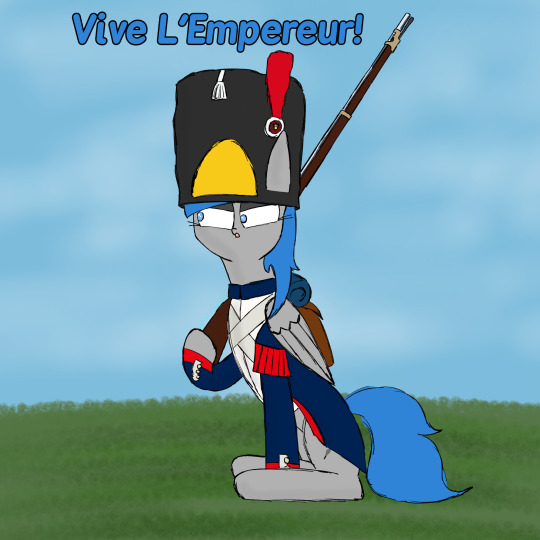
"Of all the wars I have waged
To propel my nations might
For this I'll be remembered
From now 'till the end of time
If To the victor goes the spoils
I may die an impoverished man
For in the end irony
Has dealt the cruelest hand"
- Waterloo by Iced Earth
----------------------------------------
On this day, 208 years ago, the battle of Waterloo was fought. This engagement was part of the Hundred Days campaign, in which the newly returned French Emperor, Napoleon Bonaparte, attempted to regain control of France and secure his reign. Fearing another attempt by Napoleon to conquer Europe, various European nations formed the Seventh Coalition.
At first, the tides of war seemed to be in Napoleon's favor as he defeated a Prussian force in the battle of Ligny on June 16. Meanwhile, on that same day, Marshal Ney, commanding the left wing of the army, defeated an Anglo-Dutch force at the battle of Quatre Bras.
Napoleon would then detach the right wing of his army to pursue to retreating Prussians, while he and the army reserves joined Marshal Ney's left wing to pursue the Anglo-Dutch force. This latter force, under the command of Sir Arthur Wellesley, the Duke of Wellington, would eventually halt their march on a ridge south of the town of Waterloo. There, Wellington, a commander who is a master of defense, decided to hold his ground and prevent Napoleon marching on to Brussels.
On June 18, the battle of Waterloo would be fought. During the day, Napoleon desperatelt tried to break through the Anglo-Dutch lines. This resulted in many famous engagements, such as the fight to capture the farm house at Hougoumont, the charge of the British heavy cavalry, the fight for the La Haye Sainte farm house, and the charge of the French cavalry against the British squares.
However, by the afternoon, a new force was approaching the battlefield. It turned out to be the Prussians. Managing to outmarch the French army's right wing, the Prussian force followed the sound of the guns and soon began to outflank Napoleon.
In one last bid to break the Anglo-Dutch lines, Napoleon threw in his Imperial Guard, which included his veteran and elite Old Guard. (Contrary to popular belief, the Old Guard did not directly engage against the Anglo-Dutch lines and just acted as a reserve behind the Middle Guard)
The Imperial Guard was Napoleon's last chance to secure victory, or at least a draw. But it failed. The Guard failed to break the line and Napoleon had to be persuaded to abandon the field, as Anglo-Dutch and Prussian forces closed in on his disintrigating army.
It was over for Napoleon. Eventually he would be caught and would be exiled to the lonely Atlantic island of Saint Helena.
#Silver Wing#Art#Random Art#MLP#My Little Pony#Pegasus#History#Battle of Waterloo#Napoleon#Imperial Guard#Old Guard#Yea I got to admit I almost forgot about the anniversary of the battle#I had to quickly rush this piece before it was too late XD
12 notes
·
View notes
Text
Kali est la terrifiante déesse de la Destruction, de la Transformation et de la Préservation.
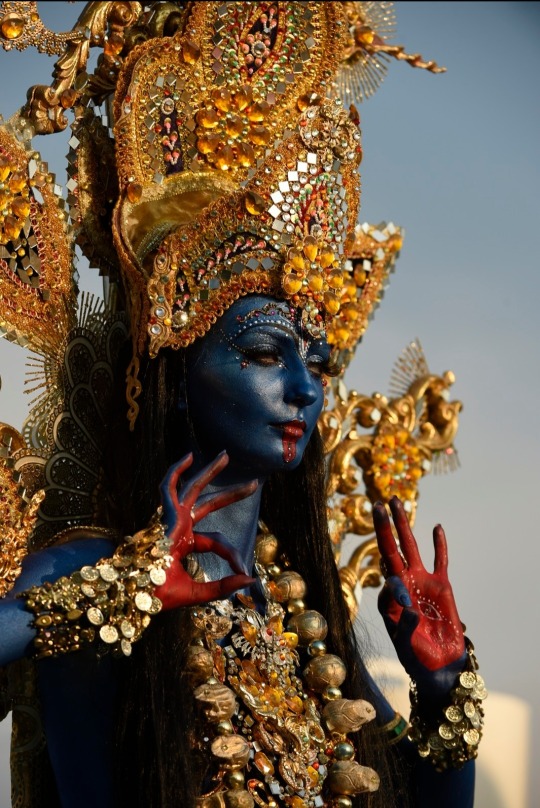
Kali like Durga or Parvati, is a representation of Shakti, the mother goddess. Kali is the most terrifying representation of the Hindu pantheon. She is represented with several arms, her neck surrounded by a garland of skulls and her waist surrounded by severed forearms. She has red eyes and tongue and black skin. It also represents time
The gods appealed to her because they could not defeat the demon Raktabija whose every drop of blood that fell to the ground gave birth to a new demon. During the battle against Raktabija, she used her tongue to prevent the demon's blood from falling to the ground.
But it poisoned her and she went mad. She danced frantically, excited by the flesh of the corpses under her feet, jeopardizing the balance of the world.
To appease him, Shiva lay down under his feet, which stopped the destructive dance.
In the Vedas, this qualifier of Kali is associated with the name of Agni, the god of fire, who possessed seven fiery and moving tongues. Kali was one of these languages, the blackest and most terrible. But this sense of the word was lost; there remained only that of the goddess Kali, the furious wife of Shiva, his Shakti, also designated as the Divine Mother Goddess-Mother. As the Divine Mother, Kali is often depicted dancing or uniting sexually with Shiva. While Shiva embodies the transcendental aspect, she symbolizes the dynamic aspect, the primitive energy. In her Bhavatarini, redeemer of the universe, she stands upright on the reclining body of her husband Shiva. She wears a belt of severed arms, a necklace of skulls and has four arms. His lower left hand holds a bloodied demon's head and his upper left hand holds a saber. With her upper right hand, makes a sign that marks the temerity of her lower right hand, she grants her benefits. She destroys ignorance maintains the order of the world, blesses and delivers those who aspire to the knowledge of God. Kali is the symbol of dissolution and destruction. She is particularly revered in Bengal. His best known temples are at Kalighat and Dakshineshvara where Ramakrishna officiated as a Kali priest.
Kali comme Durga ou Parvati, est une représentation de Shakti, la déesse-mère. Kali est la représentation la plus terrifiante du panthéon hindou. Elle est représentée avec plusieurs bras, et le cou ceint d'une guirlande de cranes et la taille entourée d'avant-bras coupés. Elle a les yeux et la langue rouges et la peau noire. Elle représente aussi le temps
Les dieux firent appel à elle car ils ne parvenaient pas à vaincre le démon Raktabija dont chaque goutte de sang qui tombait au sol donnait naissance à un nouveau démon. Lors de la bataille contre Raktabija, elle se servit de sa langue pour empêcher le sang du démon de tomber au sol.
Mais cela l'empoisonna et elle devint folle. Elle dansa frénétiquement, excitée par la chair des cadavres sous ses pieds, mettant en péril l'équilibre du monde.
Pour l'apaiser, Shiva se coucha sous ses pieds, ce qui arrêta la danse destructrice.
Dans les Veda, ce qualificatif de Kali est associé au nom d'Agni, le dieu du feu, qui possédait sept langues enflammées et mouvantes. Kali était l'une de ces langues, la plus noire et la plus terrible. Mais ce sens du mot se perdit ; il ne resta que celui de la déesse Kali, la furieuse épouse de Shiva, sa Shakti, également désignée comme la Divine Mère Déesse-Mère. En tant que Divine Mère, on représente souvent Kali en train de danser ou s'unir sexuellement avec Shiva. Tan que Shiva incarne l'aspect transcendantal, elle symbolise l'aspect dynamique, l'énergie primitive. Dans son de Bhavatarini, rédemptrice de l'univers elle se dresse debout sur le corps allongé de son époux Shiva. Elle porte une ceinture de bras coupés, un collier de cranes et possède quatre bras. Sa main inférieure gauche tient une tête de démon ensanglantée et sa main supérieure gauche un sabre. De sa main supérieure droite, fait un signe qui marque la témérité de sa main inférieure droite, elle accorde ses bienfaits. Elle détruit l'ignorance maintient l'ordre du monde, bénit et délivre ceux qui aspirent à la connaissance de Dieu. Kali est le symbole de dissolution et de la destruction. On la vénère particulièrement au Bengale. Ses temples les plus connus se trouvent à Kalighat et Dakshineshvara où Ramakrishna officia comme prêtre Kali.
0 notes
Photo

The deployment of the artillery battery under Captain Cleeves during the battle of Quatre Bras. A roundshot fired from the French battery in the top left of the painting can be seen striking the roadway on the right as the battery seeks to unlimber and support the Allied troops in the mid foreground.
#royal artillery#battle of quatre bras#quatre bras#waterloo#battle of waterloo#napoleonic#Napoleonic wars#napoleon#cannon#cannons#british army
28 notes
·
View notes
Photo



Prince of Orange leading his troops at the battle of Quatre Bras, 16 June 1815, artist - Mathieu Ignace Van Bree
93 notes
·
View notes
Text
The Duchess of Richmond's ball was a ball hosted by Charlotte, Duchess of Richmond in Brussels on 15 June 1815, the night before the Battle of Quatre Bras. Charlotte's husband Charles Lennox, 4th Duke of Richmond, was in command of a reserve force in Brussels, which was protecting that city in case Napoleon Bonaparte invaded.
Elizabeth Longford described it as "the most famous ball in history". "The ball was certainly a brilliant affair", at which "with the exception of three generals, every officer high in [Wellington's] army was there to be seen".

Before Waterloo by Henry Nelson O'Neil
143 notes
·
View notes
Text
Anonymous asked: I loved your fantastic account of the battle of Waterloo and how each nation came to define the rest of the century for all the European countries in different ways. However what are your thoughts about the battle itself? Did Wellington win it or did Napoleon lose it? What were the turning points that you think determined the fate of the battle?
Thank you for reading and liking my previous post on Waterloo. I did heavily lean into studying ancient classical warfare when I was studying Classics but I only got into Napoleonic warfare because of a father who was (and still remains) big Napoleonic warfare military enthusiast. Through his keen eyes as a former serving military man, I also looked at the battle as a soldier might as well putting on my academic critical thinking cap. It’s a popular parlour game not just in Sandhurst but also in the officers’ mess (where those regiments actually fought at Waterloo) and around dinner tables - in my experience anyway.
I’ve always seen such speculative and counterfactual questions as an amusing diversion. I’ve never seriously looked at the detail until I came to France and unexpectedly interacted with Napoleonic scholars as well as soldiers (the cultured and historically well read ones at least) that forced me to think more about it. I’ve always been of the ‘if the Prussians hadn’t arrived in time to save Wellington’ school; and this was always enough to get me by in any conversation.
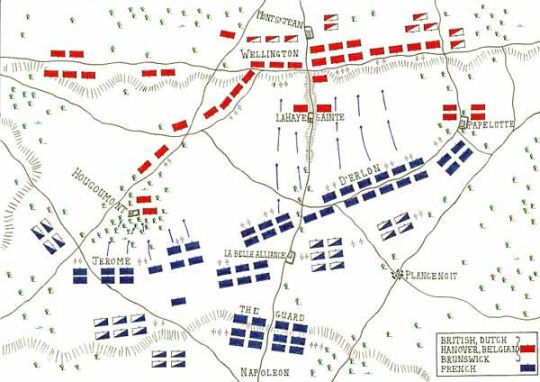
But my vanity was stung by interacting with one of my downstairs neighbours, a high decorated retired army general, with whom I played a weekly game of chess over a glass of wine during the Covid lockdown in Paris. He didn’t spare me as he knew so much detail about the battle. But a typical failing of French thinking is to pontificate around generalities rather than specific reasons. So for him it came down to pooh-poohing the generalship of Wellington (the rain saved him) and lauding the emperor (he had haemorrhoids and thus a bad day at the office). So rain and haemorrhoids were the decisive factors in determining the outcome of the battle of Waterloo.
It was clear I had to raise my game. So I’ve been reading more when I could.
I had recently finished reading a wonderful book ‘The Longest Afternoon: The 400 Men Who Decided the Battle of Waterloo’ by the Cambridge historian Brendan Simms. The book came out in 2015 but it’s been lying on my shelf for these past few years until I actually took this slim book to read on my one of my business trips.
The idea behind this short book is so superbly useful. It places to one side the huge, cinematic panorama of history and instead concentrates on one particular farmhouse, on one particular day: 18 June 1815. History is vivified, lifts itself off the page and into the mind, when a historian of Brendan Simm’s immense stature zooms in on the details - and here the details are compelling.

For the course of one day, 400 soldiers, wet, cold, in some cases hungover, who had bivouacked for the night in an abandoned farmhouse at La Haye Sainte, near a crucially strategic crossroads, found themselves staring down the massed barrels of Napoleon’s vanguard – and held them off. On June 18, 1815, Wellington established his position and sent one battalion and part of a second to the farmhouse under the command of Major Baring. Napoléon’s initial attack was a direct assault that surrounded the house and came near to breaking Wellington’s line; but it held, and the legendary charge of two British heavy cavalry brigades drove back the French.
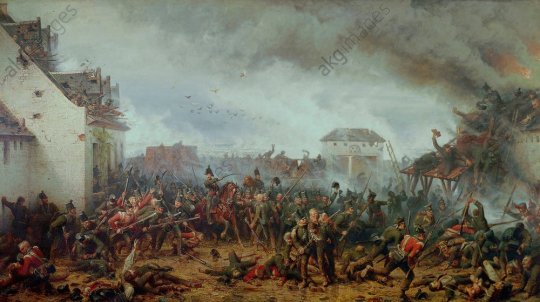
This is a detailed account of the defence of La Haye Sainte, a walled stone farmhouse forward of Wellington’s centre. Its defenders were the King’s German Legion, which (despite the British army’s penchant for oddball names) was genuinely German. Britain harboured many German expatriates who detested Napoléon, a number augmented in 1803 when he occupied Hanover and disbanded its army. That very year two ambitious officers recruited the first members of the King’s German Legion, which grew into a corps of some 14,000 men and served with distinction at Copenhagen, Walcheren and in Spain before its apotheosis at Waterloo.
Ordered to capture the farmhouse, Marshal Michel Ney - commanding Napoléon’s left wing - obeyed but became preoccupied with his famously unsuccessful cavalry attack. Reminded of the order two hours later, he dispatched infantry that reached the house and set it on fire. The men inside controlled the blaze and continued to fight until Ney took personal charge of a furious assault that succeeded only when the defenders ran out of ammunition and withdrew, having held out for six hours. Had they not defended it so stoutly and if the farm had fallen any sooner then Napoleon would have been able to get at Wellington’s troops before his Prussian reinforcements arrived, and in all likelihood Waterloo would have been a French victory instead; it would now be the name of a train station in Paris rather than London.

I doubt there is a definitive answer to this question which is why certain people love arguing about it because it’s so open ended in terms of cause and effect. You can pick on any episodic event and hail that as the decisive turning point. It’s one reason why we are so fortunate to have so many well researched history books on the battle of Waterloo to replenish the issues for a newer generation to argue with past generations.
If I were to go beyond the ‘if the Prussians hadn’t arrived to save Wellington’ line then I would point to ten decisive turning points which in themselves might not have changed the outcome but taken together certainly influenced the final outcome of one of the most important and iconic battles in history.

Napoleon gives Marshal Davout a desk job
6 June 1815 – All commanders need a good chief of staff to ensure that their intentions are translated into clear orders. Unfortunately for Napoleon – as what is arguably one of the most decisive battles in European history loomed – his trusted chief of staff, Marshal Berthier, was no longer available. Berthier had sworn an oath of loyalty to Louis XVIII – and then fallen to his death from a window – so the job was given to Marshal Soult.
Soult was an experienced field commander but he was certainly no Berthier. Napoleon’s two main field commanders were also far from ideal. Emmanuel Grouchy had little experience of independent command. Michel Ney’s heroic command of the French rear-guard during the retreat from Moscow led Napoleon to dub him “the bravest of the brave”, but by 1815 he was clearly burnt out.
Worse still, when on 6 June Napoleon ordered his generals to assemble with their troops on the Belgian border he chose to leave behind Louis-Nicolas Davout, his ‘Iron Marshal’, as minister of war. The emperor needed someone loyal to oversee affairs at home but the decision not to take with him the ablest general at his disposal would deprive him of the one commander who might have made a difference.
Constant Rebecque ignores orders
15 June – In June 1815 Napoleon assembled 120,000 men on the Belgian border. Opposing him were 115,000 Prussians under Field Marshal Blücher and an allied force of about 93,000 men under Wellington. Faced with such odds, Napoleon’s best chance of victory was to get his army between his two enemies and defeat one before turning on the other. On 15 June his army crossed the frontier at Charleroi and headed straight for the gap between the two allied armies.
Wellington was taken completely by surprise: “Napoleon has humbugged me” he said. Uncertain what Napoleon’s intentions were, he ordered his army to concentrate around Nivelles, over 12 miles away from the Prussian position at Ligny. This would have left the two allied armies dangerously separated but fortunately for Wellington, a staff officer in the Dutch army, Baron Constant Rebecque, understood what was actually needed. He disregarded Wellington’s order and instead sent a force to occupy the key crossroads of Quatre Bras, much nearer to the Prussians.

D’Erlon misses the show
16 June – Two battles were fought on 16 June. While Marshal Ney took on Wellington’s army as it hurriedly tried to concentrate around Quatre Bras, Napoleon led the main French force against the Prussians at Ligny. Blücher’s inexperienced Prussians were given a severe mauling but despite this they managed to fall back in relatively good order.
This was partly due to a disastrous mix-up on the part of the French. Confusion over orders saw General D’Erlon’s corps instructed to leave Ney’s army at Quatre Bras and join the fighting at Ligny only to be recalled as soon as they got there. The result was that 16,000 Frenchmen who could have intervened decisively actually took part in neither battle.
Blücher stays in touch
17 June – Wellington succeeded in beating back Ney at Quatre Bras but Blücher’s defeat left the British general with a large French army on his eastern flank. He was forced to fall back northwards towards Brussels. The Prussians were retreating as well. Normally a retreating army tries to withdraw along its lines of communication (ie the route back to its base). Had the Prussians done this they would have headed eastwards. The two allied armies would then have been even further apart and Wellington would have been overwhelmed. But instead of doing that, the Prussians retreated northwards towards Wavre. It was to be a crucial move. The two allied armies stayed in contact and on 17 June Wellington was able to fall back to the ridge at Mont St Jean, and prepare to make a stand there until Blücher’s Prussians could come to his aid.

The weather takes a hand
17 June – The night before the battle was marked by a thunderstorm of biblical proportions. Rain lashed down, turning roads into quagmires and trampled fields into seas of mud.
It was a night of tremendous rain and cloudbursts. Wellington said that even in the monsoons in India, he’d never known rain like it. To wake up cold and damp, wet and terrified, then you have this slaughter in a very small space. By evening there were over 200,000 men struggling to kill each other within four square miles.
Private Wheeler of the 51st Regiment later wrote: “The ground was too wet to lie down… the water ran in streams from the cuffs of our Jackets… We had one consolation, we knew that the enemy were in the same plight.” Wheeler was right of course – the rain would inconvenience all three armies, not least the Prussians as they struggled along narrow country lanes to link up with Wellington.
It’s often said that Napoleon delayed starting the battle in order to allow the ground to dry out but the chief cause of the delay was probably the need to allow his units, many of whom had bivouacked some distance away, to take up their allotted places. Napoleon enjoyed a considerable advantage in artillery at Waterloo but this was lessened by the fact that the mud made it difficult to move his guns around and that cannonballs, normally designed to bounce along until they hit something, or someone, often disappeared harmlessly into the soggy ground. Macdonnell closes the gates
11:30am, 18 June – On 18 June the two armies prepared to do battle. Most of Wellington’s troops were sheltered from enemy fire on the reverse slope of the Mont St Jean ridge. The position was protected by three important outposts: a group of farms to the left, the farm of La Haye Sainte in front and the farmhouse of Hougoumont to the right.
At about 11.30am the French launched their first attack – an assault on Hougoumont. This soon developed into a battle within a battle as the French threw in ever more men in a bid to capture the vital chateau. They nearly succeeded: led by a giant officer nicknamed ‘the Smasher’, a group of French soldiers worked their way round to the rear of the chateau, forced open its north gate and burst inside.
James Macdonnell, the garrison commander, acted quickly. He gathered a group of men and they heaved the gate shut again. The French inside the chateau were then hunted down and killed. Only a young drummer boy was spared. Hougoumont was to remain in allied hands all day and Wellington later commented that the entire result of the battle depended on the closing of those gates.

Ney loses his head after his cavalry founders
1.30pm – The infantry of D’Erlon’s corps finally saw action as they attacked the left wing of Wellington’s army. As they reached the crest of the ridge they were met by the infantry of Sir Thomas Picton’s division. Picton, a foul-mouthed Welshman who rode into battle in a civilian coat and round-brimmed hat, was shot dead but his men stopped the French, who were then driven back by Wellington’s cavalry.
The next major French attack was very different. Ney unleashed his cavalry in a mass frontal attack, and thousands of Napoleon’s famous cuirassiers – big men in steel breastplates riding big horses – thundered up the hill. But Wellington’s infantry stayed calm. Forming squares, they presented in all directions a hedge of bayonets that no horse could be made to charge.
Ney needed to call the cavalry off or support them with infantry but he lost his head and threw more horsemen into the fray. When he abandoned these fruitless attacks, Wellington’s line was still unbroken, two hours had been wasted, and the Prussians were arriving in force.

The Prussians arrive
4.30pm – Blücher had promised to come to Wellington’s aid, and kept his word. Napoleon had detached nearly a third of his army under Grouchy to prevent the Prussians joining up with Wellington but Grouchy failed to do this and, by mid-afternoon, the first Prussian units were in action on the battlefield.
At about 4.30pm they launched their first attack upon the key village of Plancenoit near the rear of Napoleon’s main position. This savage battle would rage for over three hours. Faced with this, Napoleon was forced to send many of his remaining reserves to shore up his position – leaving him with precious few troops to exploit any success his troops might enjoy against Wellington.

Napoleon says no, and von Zeithen turns back
6.30pm – At about 6.30pm the French captured La Haye Sainte. Posting artillery and skirmishers around the farm, they unleashed a storm of shot, shell and musketry into Wellington’s exposed centre. The regiments there suffered horrendous casualties, but Wellington’s line held – just.
Ney asked for reinforcements to press home his advantage but Napoleon refused. Instead he sent troops to recapture Plancenoit which had just fallen to the Prussians. Von Zeiten’s Prussian I Corps arrived on the scene. These much-needed reinforcements were set to join Wellington when a Prussian aide de camp rode up with an order from Blücher instructing them to head south and support his troops at Plancenoit. Von Zeiten obeyed. Realising that Von Zeiten’s troops were desperately needed on the ridge, Baron von Müffling, Wellington’s Prussian liaison officer, galloped after Von Zeiten and pleaded with him to ignore this new order and stick to the original plan. The Prussian general turned back and took his place on Wellington’s left, enabling the duke to shift troops over to reinforce his crumbling centre. The crisis had passed.
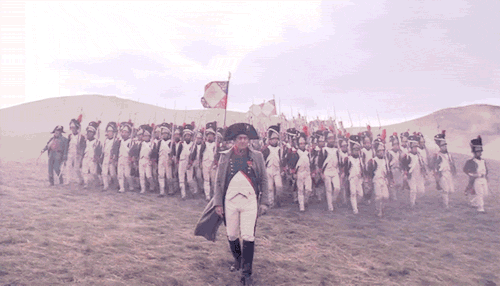
Napoleon’s last roll of the dice ends in panic
7.30pm – With Plancenoit back in French hands the stage was set for the final act in the drama. At about 7.30pm Napoleon unleashed his elite imperial guard in a last desperate bid for victory. But it was too late – they were hopelessly outnumbered and Wellington was ready for them. His own troops had been sheltering from the French fire by lying down but when the two large columns of French guardsmen reached the crest of the ridge Wellington ordered his own guards to stand up. One British guardsman describes the scene: “Whether it was (our) sudden appearance so near to them, or the tremendously heavy fire we threw into them but La Garde, who had never previously failed in an attack, suddenly stopped.”
Meanwhile Sir John Colborne of the 52nd Light Infantry wheeled his regiment round to attack the flank of the first French column while General Chasse ordered his Dutch and Belgian troops forward against the other. Soon both French columns had withered away under the deadly fire. Their defeat led to widespread panic in the French army: amid cries of “La Garde recule” (“the Guard is retreating”) it dissolved into a disorderly retreat mercilessly harried by the Prussians. “The nearest-run thing you ever saw in your life,” as Wellington described the battle, was over.
This isn’t an exhaustive list but it will do.
Waterloo was a watershed moment for Europe, and indeed the world. The end of the Napoleonic Wars heralded a peace in Europe which was not broken until the outbreak of World War One in 1914. In the century following the Battle of Waterloo an increased respect developed for the figure of the soldier. True the Battle became mythologised in the nineteenth century and is now embedded in our cultural memory as one of the great British success stories.
We still celebrate Waterloo because it was a great British victory - even if we had a little bit of help from the Prussians. It embodied the British bulldog spirit and marked the moment we finally overcame Napoleon and his empire after a decade of being at war.
The ramifications from Waterloo and the Napoleonic Wars are still felt today in contemporary European politics. I think because of this the battle continues to fascinate and to court intense discussion and disagreement.
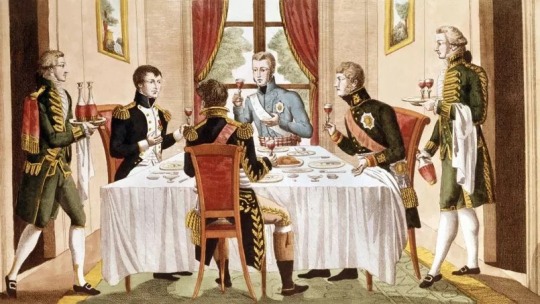
No doubt my French neighbour the retired army general and I will continue to stubbornly argue our differing viewpoints until the wine bottle empties. But we both agree that we would enjoy having dinner with Napoleon and talk about his military campaigns. I admire Napoleon a little more having read more and for living in France. He’d be a very amusing and stimulating companion.
In many ways, he was also an enlightened and intelligent ruler. His Code Napoleon is an extremely enlightened law code. At the same time this is a man who had a very, very low threshold for boredom. I think he was addicted to war.
General Robert E. Lee, at Fredericksburg said, “It is well that war is so dreadful, otherwise we would grow too fond of it.”
Napoleon would never have agreed with that. War was his drug. There’s no evidence that Wellington enjoyed war. He said after Waterloo, and I believe him, “I pray to God that I have fought my last battle.” He spent much of the battle saying to the men, “If you survive, if you just stand there and repel the French, I’ll guarantee you a generation of peace.” He thought the point of war was peace. And he sure gave not just Britain but also an entire European continent some respite from the spilling of blood on a battlefield.
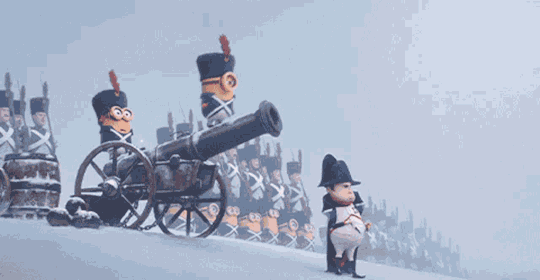
Thanks for your question.
#question#ask#waterloo#battle#battle of waterloo#napoleon#wellington#history#britain#france#prussia#austria#german#europe#military#british army#soldier
89 notes
·
View notes
Photo

The Duchess of Richmond's ball was a ball hosted by Charlotte, Duchess of Richmond in Brussels on 15 June 1815, the night before the Battle of Quatre Bras. Charlotte's husband Charles Lennox, 4th Duke of Richmond, was in command of a reserve force in Brussels, which was protecting that city in case Napoleon Bonaparte invaded.
Elizabeth Longford described it as "the most famous ball in history". "The ball was certainly a brilliant affair", at which "with the exception of three generals, every officer high in [Wellington's] army was there to be seen".
The proceedings were interrupted soon after the arrival of the Duke of Wellington, when he was notified of Napoleon's unexpected advance on the nearby crossroads of Quatre Bras. This forced him to depart after ordering his officers to leave to join their regiments. Some of the officers would soon die in battle and the poignancy of the drama has provided an enduring theme for artists, novelists and poets.
https://en.wikipedia.org/wiki/Duchess_of_Richmond%27s_ball
5 notes
·
View notes
Photo

Charlotte Is Writing To The Prime Minister At Warwick House, the news was, for the most part, a relief. Napoleon had decided to strike at the right flank and try to take on the allies one at time.
#arthur wellesley 1st duke of wellington#black brunswickers#caroline of brunswick queen of the united kingdom (princess of wales)#charlotte&leopold#frederick duke of york#frederick william duke of brunswick#george IV (prince of wales and prince regent)#james chambers#lieutenant charles hesse#mrs gagarin#napoleon bonaparte the emperor of the french#prince leopold of saxe-coburg-gotha (later king of the belgians)#princess charlotte of wales#quatre bras#robert banks jenkinson 2nd earl of liverpool#the battle of waterloo#the napoleonic wars#warwick house#weymouth#william II of the netherlands (hereditary prince of orange)
1 note
·
View note
Text
Events 6.16
363 – Emperor Julian marches back up the Tigris and burns his fleet of supply ships. During the withdrawal, Roman forces suffer several attacks from the Persians. 632 – Yazdegerd III ascends the throne as king (shah) of the Persian Empire. He becomes the last ruler of the Sasanian dynasty (modern Iran). 1407 – Ming–Hồ War: Retired King Hồ Quý Ly and his son King Hồ Hán Thương of Hồ dynasty are captured by the Ming armies. 1487 – Battle of Stoke Field: King Henry VII of England defeats the leaders of a Yorkist rebellion in the final engagement of the Wars of the Roses. 1586 – Mary, Queen of Scots, recognizes Philip II of Spain as her heir and successor. 1632 – The Plymouth Company granted a land patent to Thomas Purchase, the first settler of Pejepscot, Maine, settling at the site of Fort Andross. 1745 – War of the Austrian Succession: New England colonial troops under the command of William Pepperrell capture the Fortress of Louisbourg in Louisbourg, New France (Old Style date). 1746 – War of the Austrian Succession: Austria and Sardinia defeat a Franco-Spanish army at the Battle of Piacenza. 1755 – French and Indian War: The French surrender Fort Beauséjour to the British, leading to the expulsion of the Acadians. 1760 – French and Indian War: Robert Rogers and his Rangers surprise French held Fort Sainte Thérèse on the Richelieu River near Lake Champlain. The fort is raided and burned. 1779 – Spain declares war on the Kingdom of Great Britain, and the Great Siege of Gibraltar begins. 1795 – French Revolutionary Wars: In what became known as Cornwallis's Retreat, a British Royal Navy squadron led by Vice Admiral William Cornwallis strongly resists a much larger French Navy force and withdraws largely intact, setting up the French Navy defeat at the Battle of Groix six days later. 1811 – Survivors of an attack the previous day by Tla-o-qui-aht on board the Pacific Fur Company's ship Tonquin, intentionally detonate a powder magazine on the ship, destroying it and killing about 100 attackers. 1815 – Battle of Ligny and Battle of Quatre Bras, two days before the Battle of Waterloo. 1819 – A major earthquake strikes the Kutch district of western India, killing over 1,543 people and raising a 6-metre-high (20 ft), 6-kilometre-wide (3.7 mi), ridge, extending for at least 80 kilometres (50 mi), that was known as the Allah Bund ("Dam of God"). 1824 – A meeting at Old Slaughter's coffee house in London leads to the formation of what is now the Royal Society for the Prevention of Cruelty to Animals (RSPCA). 1836 – The formation of the London Working Men's Association gives rise to the Chartist Movement. 1846 – The Papal conclave of 1846 elects Pope Pius IX, beginning the longest reign in the history of the papacy. 1858 – Abraham Lincoln delivers his House Divided speech in Springfield, Illinois. 1871 – The Universities Tests Act 1871 allows students to enter the universities of Oxford, Cambridge and Durham without religious tests (except for those intending to study theology). 1883 – The Victoria Hall theatre panic in Sunderland, England, kills 183 children. 1884 – The first purpose-built roller coaster, LaMarcus Adna Thompson's "Switchback Railway", opens in New York's Coney Island amusement park. 1897 – A treaty annexing the Republic of Hawaii to the United States is signed; the Republic would not be dissolved until a year later. 1903 – The Ford Motor Company is incorporated. 1903 – Roald Amundsen leaves Oslo, Norway, to commence the first east–west navigation of the Northwest Passage. 1904 – Eugen Schauman assassinates Nikolay Bobrikov, Governor-General of Finland. 1904 – Irish author James Joyce begins a relationship with Nora Barnacle and subsequently uses the date to set the actions for his novel Ulysses; this date is now traditionally called "Bloomsday". 1911 – IBM founded as the Computing-Tabulating-Recording Company in Endicott, New York. 1922 – General election in the Irish Free State: The pro-Treaty Sinn Féin party wins a large majority. 1925 – Artek, the most famous Young Pioneer camp of the Soviet Union, is established. 1930 – Sovnarkom establishes decree time in the USSR. 1933 – The National Industrial Recovery Act is passed in the United States, allowing businesses to avoid antitrust prosecution if they establish voluntary wage, price, and working condition regulations on an industry-wide basis. 1940 – World War II: Marshal Henri Philippe Pétain becomes Chief of State of Vichy France (Chef de l'État Français). 1940 – A Communist government is installed in Lithuania. 1944 – In a gross miscarriage of justice, George Junius Stinney Jr., age 14, becomes the youngest person executed in the United States in the 20th century after being convicted in a two-hour trial for the rape and murder of two teenage white girls. 1948 – Members of the Malayan Communist Party kill three British plantation managers in Sungai Siput; in response, British Malaya declares a state of emergency. 1955 – In a futile effort to topple Argentine President Juan Perón, rogue aircraft pilots of the Argentine Navy drop several bombs upon an unarmed crowd demonstrating in favor of Perón in Buenos Aires, killing 364 and injuring at least 800. At the same time on the ground, some soldiers attempt to stage a coup but are suppressed by loyal forces. 1958 – Imre Nagy, Pál Maléter and other leaders of the 1956 Hungarian Uprising are executed. 1961 – While on tour with the Kirov Ballet in Paris, Rudolf Nureyev defects from the Soviet Union. 1963 – Soviet Space Program: Vostok 6 mission: Cosmonaut Valentina Tereshkova becomes the first woman in space.[ 1963 – In an attempt to resolve the Buddhist crisis in South Vietnam, a Joint Communique was signed between President Ngo Dinh Diem and Buddhist leaders. 1972 – The largest single-site hydroelectric power project in Canada is inaugurated at Churchill Falls Generating Station. 1976 – Soweto uprising: A non-violent march by 15,000 students in Soweto, South Africa, turns into days of rioting when police open fire on the crowd. 1977 – Oracle Corporation is incorporated in Redwood Shores, California, as Software Development Laboratories (SDL), by Larry Ellison, Bob Miner and Ed Oates. 1981 – US President Ronald Reagan awards the Congressional Gold Medal to Ken Taylor, Canada's former ambassador to Iran, for helping six Americans escape from Iran during the hostage crisis of 1979–81; he is the first foreign citizen bestowed the honor. 1989 – Revolutions of 1989: Imre Nagy, the former Hungarian prime minister, is reburied in Budapest following the collapse of Communism in Hungary. 1997 – Fifty people are killed in the Daïat Labguer (M'sila) massacre in Algeria. 2000 – The Secretary-General of the UN reports that Israel has complied with United Nations Security Council Resolution 425, 22 years after its issuance, and completely withdrew from Lebanon. The Resolution does not encompass the Shebaa farms, which is claimed by Israel, Syria and Lebanon. 2002 – Padre Pio is canonized by the Roman Catholic Church. 2010 – Bhutan becomes the first country to institute a total ban on tobacco. 2012 – China successfully launches its Shenzhou 9 spacecraft, carrying three astronauts, including the first female Chinese astronaut Liu Yang, to the Tiangong-1 orbital module. 2012 – The United States Air Force's robotic Boeing X-37B spaceplane returns to Earth after a classified 469-day orbital mission. 2013 – A multi-day cloudburst, centered on the North Indian state of Uttarakhand, causes devastating floods and landslides, becoming the country's worst natural disaster since the 2004 tsunami. 2015 – American businessman Donald Trump announces his campaign to run for President of the United States in the upcoming election. 2016 – Shanghai Disneyland Park, the first Disney Park in Mainland China, opens to the public. 2019 – Upwards of 2,000,000 people participate in the 2019–20 Hong Kong protests, the largest in Hong Kong's history.
0 notes